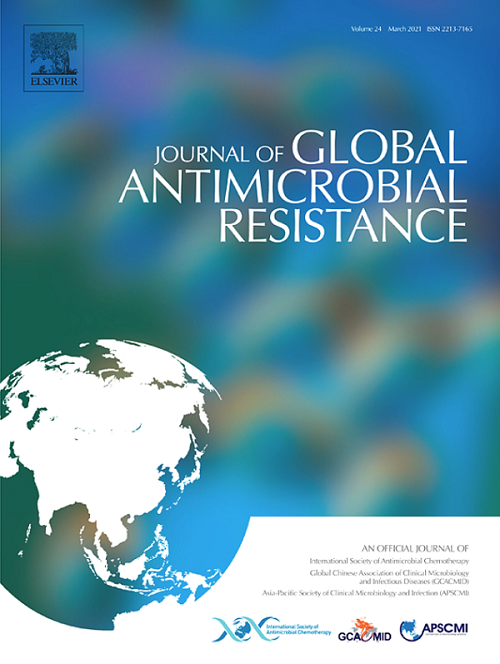东非疟疾寄生虫氯喹耐药分子标记的流行:一项系统综述和荟萃分析。
IF 3.7
3区 医学
Q2 INFECTIOUS DISEASES
引用次数: 0
摘要
背景:疟疾是由疟原虫引起的严重的全球公共卫生问题。人疟寄生虫对抗疟药物的耐药性是疟疾流行国家关注的一个公共卫生问题。氯喹对间日疟原虫和恶性疟原虫都有抗药性。据了解,氯喹耐药性遍及非洲所有恶性疟原虫流行区。分子标记在跟踪和了解抗疟药耐药性的流行方面发挥着至关重要的作用。目前,关于疟疾寄生虫中氯喹耐药分子标记的流行情况的信息不足。目的:本系统综述和荟萃分析旨在确定东非疟疾寄生虫氯喹耐药分子标记的总流行率。方法:系统检索PubMed、Scopus、Science Direct和谷歌Scholar搜索引擎中的文章。对20项可能提供疟疾寄生虫氯喹耐药标记物重要数据的研究进行了系统回顾和分析。将5种抗疟药氯喹耐药标记物分别提取到Microsoft Excel中,使用STATA 17.0进行分析。方差逆分析(I2)用于评估研究间的异质性。使用漏斗图和Egger检验来确定是否存在发表偏倚。进行了修剪和填充荟萃分析,以产生偏差调整后的效果估计。采用随机效应模型确定疟疾寄生虫中与氯喹耐药相关的分子标记的总流行率。根据国家和出版年份进行亚组分析。结果:本系统综述和荟萃分析共纳入20项研究。选取K76T、76T、N86Y、Y184F、86Y等分子标记进行meta分析。从该荟萃分析中,K76T、76T、N86Y、Y184F和86Y的总患病率分别为34.5%、47.3%、43.8%、58.3%和29.2%。在调整发表偏倚后,K76T、76T、N86Y、Y184F和86Y的估计总患病率分别为34.5%、47.3%、43.8%、58.3%和29.2%。meta分析显示,除76T、N86Y、Y184F外,K76T、86Y等所有分子标记物在不同发表年份的研究中患病率均存在显著差异。此外,meta分析显示,在国家层面上,K76T、76T、N86Y、Y184F、86Y等所有分子标记物的患病率在研究中存在显著差异。结论:本研究对东非地区疟疾寄生虫氯喹耐药分子标记进行了系统综述和荟萃分析,发现该地区存在氯喹耐药标记。因此,需要继续监测和监测氯喹耐药分子标记的流行情况,识别和限制耐药疟疾寄生虫菌株,以及开发新的抗疟疾治疗方法,以指导全世界的疟疾治疗政策、干预措施、控制和消除疟疾。本文章由计算机程序翻译,如有差异,请以英文原文为准。
Prevalence of molecular markers of chloroquine resistance in malaria parasites in East Africa: A systematic review and meta-analysis
Background
Malaria is a serious global public health problem, which is caused by genus Plasmodium. Resistance of the human malaria parasite to antimalarial drugs is a public health concern in malaria endemic countries. Chloroquine is resistant for both P. vivax and P. falciparum. Chloroquine resistance is understood throughout all of Africa's P. falciparum endemic regions. Molecular markers play a crucial role in tracking and understanding the prevalence of antimalarial drug resistance. Currently, there is inadequate information on the prevalence of molecular markers of chloroquine resistance in malaria parasites.
Objective
This systematic review and meta-analysis aimed to determine the pooled prevalence of molecular markers of chloroquine resistance in malaria parasites in East Africa.
Methods
Systematic search was performed to retrieve articles from PubMed, Scopus, Science Direct, and the Google Scholar search engine. Twenty potential studies that provided important data on markers of chloroquine resistance in malaria parasites were systematically reviewed and analyzed. Five antimalarial drug resistance markers of chloroquine resistance were extracted separately into Microsoft Excel and analyzed using STATA 17.0. The Inverse of variance (I2) was done to evaluate heterogeneity across studies. The funnel plot and the Egger's test were used to determine the existence or absence of publication bias. A trim-and-fill meta-analysis was carried out to generate a bias-adjusted effect estimate. A random effect model was used to determine the pooled prevalence of molecular markers associated with chloroquine resistance in malaria parasites. Subgroup analysis was performed based on country and year of publication.
Results
A total of 20 studies were included for this systematic review and meta-analysis. The molecular markers like K76T, 76T, N86Y, Y184F, and 86Y were selected for meta-analysis. From this meta-analysis, the pooled prevalence of K76T, 76T, N86Y, Y184F, and 86Y was 34.5%, 47.3%, 43.8%, 58.3%, and 29.2%, respectively. After adjusting for publication bias, the estimated pooled prevalence of K76T, 76T, N86Y, Y184F, and 86Y were 34.5%, 47.3%, 43.8%, 58.3%, and 29.2%, respectively. Meta-analysis showed a significant difference in all molecular marker prevalence like K76T and 86Y among studies on year of publication except 76T, N86Y, and Y184F. In addition, the meta-analysis showed a significant difference in all molecular marker prevalence like K76T, 76T, N86Y, Y184F, and 86Y among studies at the country level.
Conclusions
The findings of this systematic review and meta-analysis concerning the molecular markers of chloroquine resistance of malaria parasites in East Africa revealed a significant prevalence of antimalarial drug resistance markers of chloroquine. As a result, continued surveillance and monitoring of the prevalence of molecular markers of chloroquine resistance, identification and limitation of drug-resistant malaria parasite strains, and development of new antimalarial treatments are required to guide malaria treatment policies, interventions, control, and elimination of malaria worldwide.
求助全文
通过发布文献求助,成功后即可免费获取论文全文。
去求助
来源期刊

Journal of global antimicrobial resistance
INFECTIOUS DISEASES-PHARMACOLOGY & PHARMACY
CiteScore
8.70
自引率
2.20%
发文量
285
审稿时长
34 weeks
期刊介绍:
The Journal of Global Antimicrobial Resistance (JGAR) is a quarterly online journal run by an international Editorial Board that focuses on the global spread of antibiotic-resistant microbes.
JGAR is a dedicated journal for all professionals working in research, health care, the environment and animal infection control, aiming to track the resistance threat worldwide and provides a single voice devoted to antimicrobial resistance (AMR).
Featuring peer-reviewed and up to date research articles, reviews, short notes and hot topics JGAR covers the key topics related to antibacterial, antiviral, antifungal and antiparasitic resistance.
 求助内容:
求助内容: 应助结果提醒方式:
应助结果提醒方式:


